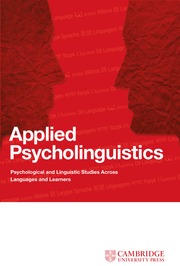Crossref Citations
This article has been cited by the following publications. This list is generated based on data provided by
Crossref.
Hardison, Debra M.
and
Sonchaeng, Chayawan
2005.
Theatre voice training and technology in teaching oral skills: Integrating the components of a speech event.
System,
Vol. 33,
Issue. 4,
p.
593.
Wang, Yue
Behne, Dawn M.
and
Jiang, Haisheng
2008.
Linguistic experience and audio-visual perception of non-native fricatives.
The Journal of the Acoustical Society of America,
Vol. 124,
Issue. 3,
p.
1716.
Wang, Yue
Behne, Dawn M.
and
Jiang, Haisheng
2009.
Influence of native language phonetic system on audio-visual speech perception.
Journal of Phonetics,
Vol. 37,
Issue. 3,
p.
344.
Hirata, Yukari
and
Kelly, Spencer D.
2010.
Effects of Lips and Hands on Auditory Learning of Second-Language Speech Sounds.
Journal of Speech, Language, and Hearing Research,
Vol. 53,
Issue. 2,
p.
298.
Joohee Son
2014.
Can Synchronous Videoconferencing Lessons Improve Korean Students’ English Pronunciation?.
English Teaching,
Vol. 69,
Issue. 1,
p.
199.
Moradi, Shahram
Lidestam, Björn
Hällgren, Mathias
and
Rönnberg, Jerker
2014.
Gated Auditory Speech Perception in Elderly Hearing Aid Users and Elderly Normal-Hearing Individuals: Effects of Hearing Impairment and Cognitive Capacity.
Trends in Hearing,
Vol. 18,
Issue. ,
Kawase, Saya
Hannah, Beverly
and
Wang, Yue
2014.
The influence of visual speech information on the intelligibility of English consonants produced by non-native speakers.
The Journal of the Acoustical Society of America,
Vol. 136,
Issue. 3,
p.
1352.
Dahl, Tove Irene
and
Ludvigsen, Susanne
2014.
How I See What You're Saying: The Role of Gestures in Native and Foreign Language Listening Comprehension.
The Modern Language Journal,
Vol. 98,
Issue. 3,
p.
813.
Kelly, Spencer D.
Hirata, Yukari
Manansala, Michael
and
Huang, Jessica
2014.
Exploring the role of hand gestures in learning novel phoneme contrasts and vocabulary in a second language.
Frontiers in Psychology,
Vol. 5,
Issue. ,
Dahl, Tove Irene
and
Ludvigsen, Susanne
2014.
How I See What You're Saying: The Role of Gestures in Native and Foreign Language Listening Comprehension.
The Modern Language Journal,
Vol. 98,
Issue. 3,
p.
813.
INCEOGLU, SOLÈNE
2016.
Effects of perceptual training on second language vowel perception and production.
Applied Psycholinguistics,
Vol. 37,
Issue. 5,
p.
1175.
Schmidtke, Jens
2016.
The Bilingual Disadvantage in Speech Understanding in Noise Is Likely a Frequency Effect Related to Reduced Language Exposure.
Frontiers in Psychology,
Vol. 7,
Issue. ,
Moradi, Shahram
Lidestam, Björn
and
Rönnberg, Jerker
2016.
Comparison of Gated Audiovisual Speech Identification in Elderly Hearing Aid Users and Elderly Normal-Hearing Individuals.
Trends in Hearing,
Vol. 20,
Issue. ,
Moradi, Shahram
Lidestam, Björn
Danielsson, Henrik
Ng, Elaine Hoi Ning
and
Rönnberg, Jerker
2017.
Visual Cues Contribute Differentially to Audiovisual Perception of Consonants and Vowels in Improving Recognition and Reducing Cognitive Demands in Listeners With Hearing Impairment Using Hearing Aids.
Journal of Speech, Language, and Hearing Research,
Vol. 60,
Issue. 9,
p.
2687.
Kelly, Spencer
Bailey, April
and
Hirata, Yukari
2017.
Metaphoric Gestures Facilitate Perception of Intonation More than Length in Auditory Judgments of Non-Native Phonemic Contrasts.
Collabra: Psychology,
Vol. 3,
Issue. 1,
Bohn, Ocke‐Schwen
2017.
The Handbook of Psycholinguistics.
p.
213.
Avivi-Reich, Meital
Puka, Klajdi
and
Schneider, Bruce A.
2018.
Do age and linguistic background alter the audiovisual advantage when listening to speech in the presence of energetic and informational masking?.
Attention, Perception, & Psychophysics,
Vol. 80,
Issue. 1,
p.
242.
Schmidtke, Jens
2018.
PUPILLOMETRY IN LINGUISTIC RESEARCH.
Studies in Second Language Acquisition,
Vol. 40,
Issue. 3,
p.
529.
Crowther, Dustin
and
Gass, Susan M.
2019.
The Cambridge Handbook of Language Learning.
p.
258.
McCrocklin, Shannon
2019.
ASR-based dictation practice for second language pronunciation improvement.
Journal of Second Language Pronunciation,
Vol. 5,
Issue. 1,
p.
98.
 /, /l/, and /s, t, k/ combined with high, low, and rounded vowels. Results support the priming role of visual cues in AV speech processing. Identification was earlier with visual cues and following training, especially for words beginning with /
/, /l/, and /s, t, k/ combined with high, low, and rounded vowels. Results support the priming role of visual cues in AV speech processing. Identification was earlier with visual cues and following training, especially for words beginning with / / and /l/, which also showed significant effects of adjacent vowel. For the Japanese, the AV advantage in identifying /
/ and /l/, which also showed significant effects of adjacent vowel. For the Japanese, the AV advantage in identifying / /- and /l/-initial words was accentuated following training. Findings are discussed within a multimodal episodic model of learning.
/- and /l/-initial words was accentuated following training. Findings are discussed within a multimodal episodic model of learning.
